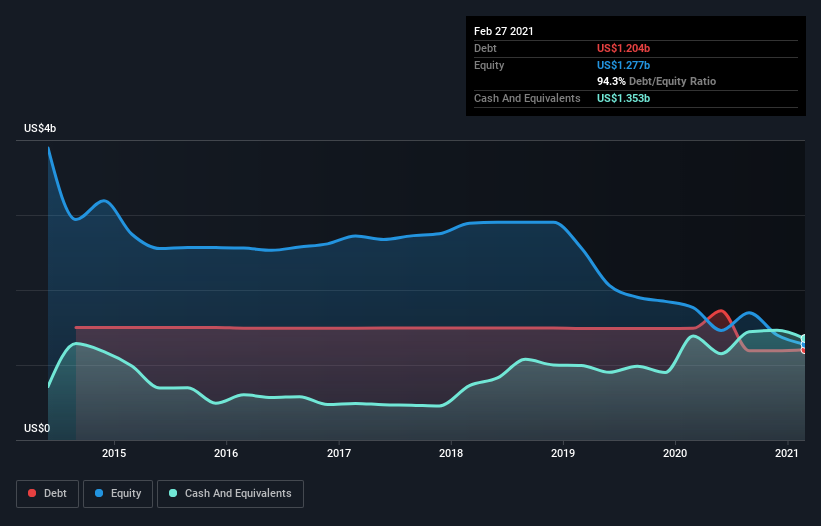We Think Bed Bath & Beyond (NASDAQ:BBBY) Is Taking Some Risk With Its Debt
David Iben put it well when he said, 'Volatility is not a risk we care about. What we care about is avoiding the permanent loss of capital.' So it might be obvious that you need to consider debt, when you think about how risky any given stock is, because too much debt can sink a company. We can see that Bed Bath & Beyond Inc. (NASDAQ:BBBY) does use debt in its business. But is this debt a concern to shareholders?
When Is Debt Dangerous?
Debt and other liabilities become risky for a business when it cannot easily fulfill those obligations, either with free cash flow or by raising capital at an attractive price. In the worst case scenario, a company can go bankrupt if it cannot pay its creditors. However, a more usual (but still expensive) situation is where a company must dilute shareholders at a cheap share price simply to get debt under control. Having said that, the most common situation is where a company manages its debt reasonably well - and to its own advantage. The first thing to do when considering how much debt a business uses is to look at its cash and debt together.
View our latest analysis for Bed Bath & Beyond
What Is Bed Bath & Beyond's Net Debt?
The image below, which you can click on for greater detail, shows that Bed Bath & Beyond had debt of US$1.20b at the end of February 2021, a reduction from US$1.49b over a year. But it also has US$1.35b in cash to offset that, meaning it has US$148.8m net cash.
How Healthy Is Bed Bath & Beyond's Balance Sheet?
According to the last reported balance sheet, Bed Bath & Beyond had liabilities of US$2.29b due within 12 months, and liabilities of US$2.89b due beyond 12 months. Offsetting these obligations, it had cash of US$1.35b as well as receivables valued at US$318.1m due within 12 months. So it has liabilities totalling US$3.51b more than its cash and near-term receivables, combined.
Given this deficit is actually higher than the company's market capitalization of US$2.69b, we think shareholders really should watch Bed Bath & Beyond's debt levels, like a parent watching their child ride a bike for the first time. Hypothetically, extremely heavy dilution would be required if the company were forced to pay down its liabilities by raising capital at the current share price. Given that Bed Bath & Beyond has more cash than debt, we're pretty confident it can handle its debt, despite the fact that it has a lot of liabilities in total.
Notably, Bed Bath & Beyond made a loss at the EBIT level, last year, but improved that to positive EBIT of US$36m in the last twelve months. The balance sheet is clearly the area to focus on when you are analysing debt. But ultimately the future profitability of the business will decide if Bed Bath & Beyond can strengthen its balance sheet over time. So if you want to see what the professionals think, you might find this free report on analyst profit forecasts to be interesting.
Finally, a company can only pay off debt with cold hard cash, not accounting profits. Bed Bath & Beyond may have net cash on the balance sheet, but it is still interesting to look at how well the business converts its earnings before interest and tax (EBIT) to free cash flow, because that will influence both its need for, and its capacity to manage debt. Happily for any shareholders, Bed Bath & Beyond actually produced more free cash flow than EBIT over the last year. There's nothing better than incoming cash when it comes to staying in your lenders' good graces.
Summing up
Although Bed Bath & Beyond's balance sheet isn't particularly strong, due to the total liabilities, it is clearly positive to see that it has net cash of US$148.8m. And it impressed us with free cash flow of US$85m, being 237% of its EBIT. So while Bed Bath & Beyond does not have a great balance sheet, it's certainly not too bad. There's no doubt that we learn most about debt from the balance sheet. However, not all investment risk resides within the balance sheet - far from it. For example Bed Bath & Beyond has 2 warning signs (and 1 which shouldn't be ignored) we think you should know about.
At the end of the day, it's often better to focus on companies that are free from net debt. You can access our special list of such companies (all with a track record of profit growth). It's free.
This article by Simply Wall St is general in nature. It does not constitute a recommendation to buy or sell any stock, and does not take account of your objectives, or your financial situation. We aim to bring you long-term focused analysis driven by fundamental data. Note that our analysis may not factor in the latest price-sensitive company announcements or qualitative material. Simply Wall St has no position in any stocks mentioned.
Have feedback on this article? Concerned about the content? Get in touch with us directly. Alternatively, email editorial-team (at) simplywallst.com.

